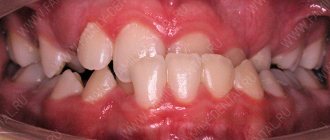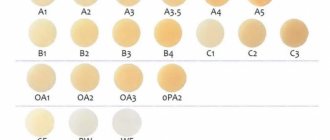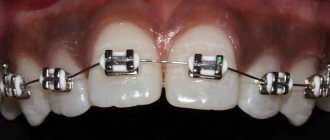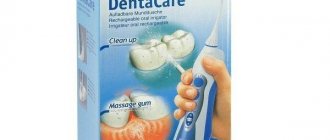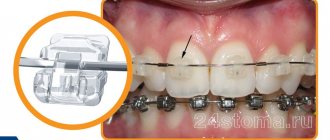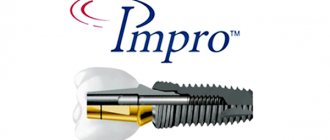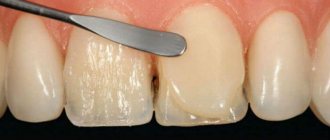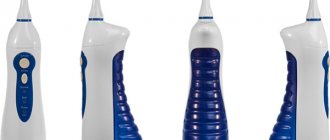7284
While wearing braces, special attention should be paid to the quality of oral hygiene, since the design makes it very difficult to clean the teeth. For this, not only special brushes are used, but also other devices that increase cleaning efficiency.
Such devices include an irrigator, which removes bacterial plaque and food debris from teeth, braces and implants using a jet of water .
What it is?
An irrigator is a small device that cleans teeth and orthodontic structures by applying a pressurized water jet to them. The device has one or two built-in pumps that draw liquid from the container.
In some cases, during the water supply process, it mixes with air, forming many microbubbles. When the jet hits the surface of the teeth, these bubbles break, disrupting the adhesion of plaque and knocking out food debris from narrow areas that are difficult to reach with a regular brush.
This is very important when wearing braces, which are characterized by the complexity of the design of the lock and other connection elements .
The irrigator has certain advantages over a regular toothbrush when used during the correction period:
- professional-level cleansing, since the flow of water enters the areas under the brackets, arches and the places where the braces join the enamel surface;
- the possibility of spot processing, due to which high-quality cleaning of the lock is carried out;
- gentle cleaning of ceramic braces, eliminating the possibility of damage;
- expanded functionality: its action is identical to the combined use of a dental brush and floss.
The irrigator is used after basic brushing with a regular toothbrush. To fill it, you can use not only ordinary water, but also medical solutions, balms and decoctions.
Replaceable attachments of the device allow all family members to use it.
Which one is better to choose?
The maximum effect from an irrigator when cleaning braces can only be achieved if the correct model is selected . These devices are presented on store shelves in a wide range.
The models differ from each other in type of construction, functionality and external design.
Fluid selection
You can use plain water, but the best effect occurs when using pharmaceutical solutions. They are hygienic (for daily cleaning) and special (prescribed by the dentist after examining the oral cavity). The latter include balms with an anti-inflammatory, hemostatic effect, products based on calcium, fluoride, and potassium to strengthen teeth.
After using the irrigator with medicinal liquid, there is no need to rinse your mouth.
You can combat the increased appearance of stones using a bleaching mixture. You can see the effect after just a few procedures. Do not direct the solution onto the gums, since small abrasive particles and strong pressure during rinsing can damage the mucous membrane. Care must be taken to ensure that the stream does not enter the larynx.
Kinds
To carry out the cleansing procedure, 3 types of irrigators are used: flow-through, stationary and portable.
All of them are used at home and do a good job of cleaning braces, but they have certain features.
Flow-through
Unlike other types, flow-type devices do not have a container for liquid. To operate, the irrigator is connected directly to the water tap using a special nozzle.
The flow-through type of device does not require preliminary water intake, and during the procedure you can use an unlimited volume of it. This system takes up little space and simultaneously with the water supply, it purifies it thanks to the built-in filter.
The disadvantage of a flow-type irrigator is that it operates in one mode and other liquids cannot be used for the procedure .
Is an electric toothbrush suitable for braces? Read our new publication.
The next article will talk about ways to correct malocclusion in adults surgically.
At the link https://orto-info.ru/ortodonticheskoe-lechenie/osnovnoy-period/uhod-za-breketami.html you will find a video with recommendations for caring for braces after installation.
Stationary
They are devices that operate from the home electrical network and are large in size. The device has a built-in storage compartment for additional attachments and a large liquid reservoir.
Even on the smallest devices, the volume of the water tank is at least 0.5 liters. The main advantage of the stationary type of irrigator is its power, which allows you to use the device in various modes with adjustable pressure, which is important for cleaning braces.
The disadvantage of this design is that when using it, it is necessary to use only filtered liquids , otherwise the device will quickly fail.
Portable
Photo: portable model of irrigator
This type is small in size and runs on a built-in battery or batteries. The portable irrigator is equipped with a small container that can hold up to 0.3 ml of liquid. This volume is enough for one cleaning procedure.
Depending on the capacity of the battery, operation of the irrigator in continuous mode and without additional recharging can last from 15 minutes to 1.5 hours. This type of irrigator also has several modes and attachments.
Its advantage is its compact size, thanks to which it does not take up much space in your bag when traveling. For frequently traveling people with braces, this device option is most suitable, as it allows high-quality cleaning of the orthodontic system in any conditions.
The disadvantages of this design include the rather large weight when the container is filled and limited modes .
The best irrigators for implants and crowns in the middle segment
WaterPik WP-462 E2 Cordless Plus
The WaterPik WP-462 E2 Cordless Plus portable irrigator has a compact design, thanks to the placement of a small water tank at the rear of the device (directly under the main control unit).
The model is made of durable plastic in a black design with gray buttons. A small control panel is provided to control the functions of the irrigator. There are two buttons on it - on/off the power supply and a regulator for two water supply modes. Additionally, the kit includes four attachments: implantological, orthodontic, for jet cleaning, and for cleaning the tongue. Each nozzle rotates 360º, which ensures maximum cleaning of all areas of the oral cavity. This irrigator is battery-powered, so it will need to be charged periodically via an AC adapter or using a USB cable. Specifications:
Working time: from 5 to 7 days;
Power type: rechargeable;
Jet pressure: 310–520 kPa;
Tank capacity: 0.21 l.
Advantages
- good pressure
- ergonomic design
- There are several attachments included
- compact size
Flaws
- small water tank
WaterPik WP-450 Cordless Plus
The compact irrigator for implants works for up to a week without recharging. The device has two modes, the maximum flow pressure is 520 kPa. The device is not the most powerful, but it fits easily in a travel bag. The set includes replacement tips - for crowns and implants, for cheeks and tongue, as well as orthodontic and jet tips.
Advantages
- battery holds charge for a long time
- The most necessary nozzles with rotation are provided
- light weight and compact dimensions
Flaws
- no charge indicator
- small tank
- only two operating modes
GESS Aqua Pro
The GESS Aqua Pro pulse irrigator is made of durable plastic in white with a blue water tank and edging parts of the same shade.
The nozzle storage compartment is located directly above the water tank. The device is equipped with eight nozzles: standard (3 pcs.), periodontal, orthodontic, for cleaning implants, for cleaning the tongue, for jet cleaning. Each of them rotates 360º, which makes it possible to thoroughly clean plaque and bacteria in the oral cavity. You can adjust the water supply pressure of the irrigator (10 modes) using a rotary wheel. You can turn the device on and off using a slide switch located on the handle of the irrigator. The automatic shutdown function of the device is activated after a three-minute operating cycle. It is necessary to protect the engine from wear and tear and ensure longer operation of the device. Specifications:
Power consumption: 12 W;
Power type: mains;
Jet pressure: 202–709 kPa;
Tank capacity: 0.6 l.
Advantages
- many attachments
- high power
- simple controls
Flaws
- strong pressure can knock off crowns
Donfeel OR-830
The stationary irrigator Donfeel OR-830 is made of durable plastic in white and blue colors.
On the left, under the capacious liquid reservoir, there is a compartment for storing nozzles. This compartment is equipped with an ultraviolet lamp to disinfect the attachments from bacteria after use. It is enough to turn on the lamp for 7 minutes once a week. The device is equipped with eight attachments: standard (3 pcs.), periodontal, orthodontic, nasal, for cleaning implants, for cleaning the tongue. The operation of the irrigator can be adjusted using two swivel wheels. The top wheel turns the device on and off and also turns on the ultraviolet light in the disinfection compartment. The lower wheel regulates the water supply pressure (10 modes). You can also limit the water supply to the nozzle using the button on the handle. Specifications:
Power consumption: 18 W;
Power type: mains;
Jet pressure: 60–680 kPa;
Tank capacity: 1 l.
Advantages
- many attachments
- strong pressure
- UV lamp for disinfection
Flaws
- Some models may leak water from the tank
Modes
Basically, when choosing an irrigator for cleaning the bracket system, dentists recommend focusing on the number of modes and their functionality.
Most often they are equipped with the following modes :
- Standard . This mode is available on all types of irrigators. It is a monostream, supplied in one continuous stream. It has good washing ability, but is ineffective for cleaning braces.
- Pulsating .
It is supplied in the form of a pulsating thin jet that delivers micro-impacts that effectively remove deposits by breaking their bond with the surface. A thin jet allows you to target the elements of the orthodontic structure and clean its most inaccessible areas. - Microbubble. This mode not only allows you to completely remove plaque, but also has an antibacterial effect.
Microbubble mode technology involves the simultaneous supply of water and air, which are mixed during the intake process.When such a jet is applied to the surface to be cleaned, microbubbles penetrate into all corners of the structure and burst, creating an explosion effect, which helps to destroy bacterial plaque and wash it out of the system.
In addition to the jet modes, it is necessary to pay attention to the possibility of adjusting the flow rate of the water flow. This will allow the treatment to be carried out by people with both normal gum sensitivity and increased sensitivity.
Can the device cause harm?
We found out what benefits the irrigator brings to the teeth and oral cavity, but can it cause harm?
There are practically no contraindications for use. But people with acute forms of gingivitis or periodontitis, as well as patients who have recently undergone dental surgery, for example, installation of an implant, can use this device only after complete recovery.
We advise you to use it in strict accordance with the instructions and recommendations of your doctor. This is the only way to achieve optimal results.
But keep in mind that if used daily for more than 15 minutes, it is possible not only to increase sensitivity, but also to cause bleeding gums. Thus, calling into question the usefulness of the irrigator - is it needed at all?
Please note that to cleanse the oral cavity, it is better to take at least plain boiled water. This will significantly reduce the risk of harmful bacteria entering the body from the water supply.
Replaceable attachments
Depending on the model, the irrigator can be equipped with various types of attachments, each of which has a specific purpose.
Standard
Designed for routine cleaning of the oral cavity. It has a curved neck and a small diameter nozzle, allowing you to wash 1-2 teeth at a time.
This attachment does a good job of cleaning braces, but does not allow you to carry out this procedure in detail .
Orthodontic
The main function of this type of attachment is to clean any orthodontic structure, including braces. It has an elongated nozzle located on a curved neck and equipped with a tapered tip. It delivers a thin, powerful jet and allows for precise treatment of each element of the system .
Thanks to this attachment, the locks of the braces and the area of their contact with the tooth surface are thoroughly cleaned, even in the most remote areas.
Massage
It is a nozzle with a round head, the entire area of which contains bristles. Designed to massage and strengthen periodontal tissue.
Dentists recommend using a massage attachment while wearing braces, since the correction procedure is associated with a constant feeling of discomfort or dull pain caused by the movement of teeth.
Gum massage stimulates tissue blood flow, which helps relieve pain and accelerates the regeneration process .
As a rule, all attachments are color-coded, which allows only one person to use them.
Periodontal
It is not intended to clean braces, but can significantly improve the overall health of the oral cavity by thoroughly rinsing periodontal pockets.
This type of attachment is recommended for people with periodontal problems .
To remove plaque
The attachment can be used both to remove plaque from the surface of teeth and from the braces system. It is equipped with three tufts of elastic bristles, which mechanically remove bacterial deposits simultaneously with the water supply.
In order to make the brushing process as effective as possible, during the procedure it is necessary to carry out the same movements as when using a regular toothbrush .
How often is it recommended to change?
Dentists recommend changing irrigator heads, which have bristles or rubber tips, once a quarter. And standard ones, made exclusively of plastic - once every six months.
This recommendation is due to the fact that over time, with constant use, parts wear out and become deformed. Violation of the design of the nozzle negatively affects the quality of oral care, reduces the effectiveness of the hygiene procedure, and increases the risk of developing caries and other diseases. A deformed tip can injure the gums and mucous membranes, and during long-term use, pathogenic bacteria accumulate in the bristles. Changing brush heads on a timely and regular basis is important for maintaining the dental health of the entire family.
Instructions for use
The use of the device begins with its preparation. To do this, the tank is filled with warm water, which must be cleared of various impurities.
If the device is being used for the first time, it is necessary to perform additional cleaning by collecting a full container of water and passing it through the nozzle in the standard mode. Then set the required mode and water supply speed.
The cleansing procedure must be carried out by bending over a container or sink into which water from the oral cavity will drain.
Is it always possible to wear braces during pregnancy? We’ll talk about it in the next review.
In this material we will discuss how to correct mesial overbite.
Here https://orto-info.ru/ortodonticheskoe-lechenie/osnovnoy-period/vosk-dlya-breketov.html we’ll figure out what protective orthodontic wax for braces is.
Cleaning is carried out in several steps:
- the mouth is opened slightly so that the water can flow freely, and the nozzle is directed to the dentition, starting with the last molars;
- First, each bracket is cleaned, paying special attention to the lock and the area where the system adheres to the enamel surface;
- after this, direct the jet to the gum line area and the spaces between the teeth;
- the remaining surface of the dentition is treated last.
In conclusion, it is recommended to massage the periodontium, gently acting on it with a stream of water.
How to clean braces with an irrigator, watch the video:
After the procedure, the device must be completely emptied and dried if possible.
The best manufacturers of oral irrigators
Not all companies developing oral irrigators match their technologies with the latest scientific knowledge in the field of dentistry. Because of this, only a limited group of manufacturers can be trusted. The list of the best includes:
- WaterPik is one of the most famous manufacturers of irrigators, which appeared in 1962 in the USA;
- B.Well produced using British technologies; this brand has been available in Russia for almost 13 years;
- Revyline is a domestic manufacturer of high-quality irrigators in various price segments;
- Donfeel is a Russian leader in the production of oral hygiene devices;
- Oral-B company originated in the USA and is still included in the ranking of the most famous international companies.
Price
The cost of the irrigator will depend on the type of model. The most affordable are portable devices, the price of which varies from 480 to 3500 rubles .
Devices costing up to 1000 rubles, as a rule, do not have special attachments and are equipped with a small reservoir. More expensive models have expanded functionality and a set of additional attachments.
Stationary devices can be purchased at a price of 2,900 rubles . It can increase depending on the number of modes, nozzles and levels of fluid supply adjustment.
The average cost of budget irrigators from well-known manufacturers, with various modes, is 4,500 rubles. Particularly popular are Donfeel OR-820M, Oral-B ProfessionalCare OxyJet MD20, Waterpik WP-70.
When choosing a device, you need to focus not only on the cost, but also on the possibility of servicing the device. In its absence, a breakdown of the irrigator will lead to the need for a new forced purchase.
Reviews
Irrigators are one of those devices whose convenience can only be appreciated by using them. The impression made largely depends on the specific model.
If you use an irrigator, tell us what type it is and what impression it leaves on you. The comment form is at the bottom of this page.
If you find an error, please select a piece of text and press Ctrl+Enter.
Tags vestibular braces care
Did you like the article? stay tuned
Previous article
What makes ODP braces different from other systems?
Next article
Taking an impression using the open and closed tray method is the first step to implantation success
Let's sum it up
An irrigator is an effective home tool for maintaining oral hygiene. With its help, you can easily and efficiently clean your teeth and all hard-to-reach places from germs and food debris, thereby reducing the likelihood of various diseases, eliminating unpleasant odors and extending the life of fillings and crowns. It is indispensable for the care of orthodontic structures and is a reliable prevention of periodontitis for people suffering from diabetes.
There are practically no contraindications for its use. We recommend using the irrigator according to the instructions of your doctor and the instructions for use.
All family members can use one device, but for hygiene reasons, each person should purchase their own attachment. Children can begin the procedure after replacing baby teeth with permanent teeth, but under adult supervision. Teenagers can independently use the same device as their parents.
It is easy to operate and maintain. You can easily purchase a high-quality device with all the necessary functions at an affordable price.
In this article, we tried to talk as simply and clearly as possible about why an irrigator is needed. Remember that its use is an additional hygiene procedure. It is impossible to replace the use of a toothbrush, and the maximum effect is achieved with regular use in accordance with the recommendations of the attending physician.
